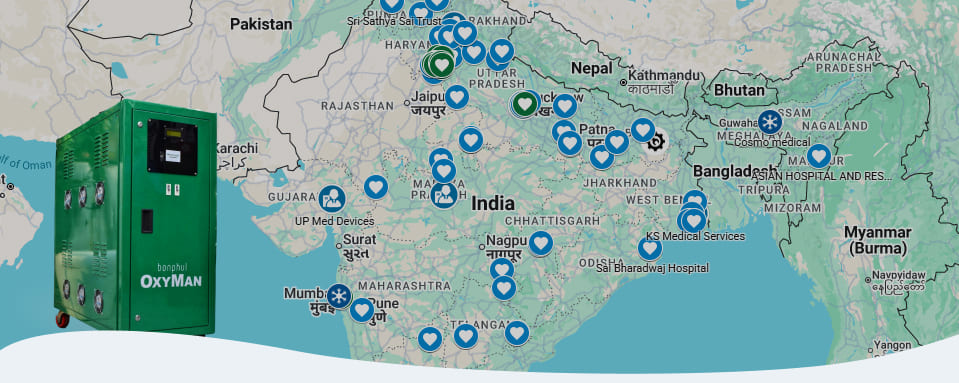- +91 9999884886
- info@bonphulapl.com
- C 47 Ground Floor, Sector 65, Noida, Uttar Pradesh

Bonphul Air Products today announced that its flagship medical-oxygen generator, Bonphul OxyMan, has been installed in over 70 hospitals across India over the past three years. The installations stretch from Leh (northernmost) to Imphal (easternmost), Trivandrum (southernmost) to Banswara (westernmost), demonstrating the product’s adaptability to India’s extreme geographies and variable infrastructure.
Bonphul OxyMan is designed and marketed as the world’s most compact, energy-efficient and affordable medical-oxygen generator: smaller than a home refrigerator, consuming less than 3 units of power (comparable to a split AC), and costing about half the price of similar imported systems (company claim). The company positions OxyMan as a robust, low-footprint on-site oxygen source appropriate for district hospitals, small private hospitals, nursing homes and rural health facilities.
India’s traditional hospital oxygen supply remains heavily dependent on cylinder logistics and centralized liquid oxygen (LOX) or PSA plant networks. During peaks of demand—most notably in the COVID-19 crisis—that dependence exposed severe vulnerabilities: long supply lines, transport bottlenecks, maintenance gaps and outages that threatened patient care. Independent reviews of India’s pandemic response and subsequent studies show the fragility of cylinder-centric logistics and the urgent need for decentralized, reliable oxygen sources at the point of care.
Many hospitals have since explored on-site generation solutions (PSA/PSA-based plants, concentrators and small generators). However, large PSA plants can be expensive to install and maintain, and in some regions pandemic-era PSA plants have become underused or unmaintained — reinforcing the need for smaller, energy-efficient, low-maintenance alternatives that can act as direct replacements for cylinder supply.
Bonphul OxyMan is designed to be a plug-and-play alternative to cylinder-based supply:
Estimates of India’s medical-oxygen market vary depending on definitions (medical oxygen services, generators, concentrators, cylinders, and related infrastructure). Some industry analysts estimate the India medical oxygen market at roughly USD 163 million in 2024 with steady growth ahead; other broader industry analyses put the wider oxygen market (including LOX and large industrial segments) at substantially higher values. These variations reflect differing scopes—but all reputable sources indicate a sizable and growing market for on-site oxygen solutions as hospitals shift from cylinder dependence toward decentralized systems.
Bonphul emphasises that reliable oxygen delivery is more than a generator: it requires correct system sizing, medical-grade output, safe gas piping, alarms, redundancy and trained operators. OxyMan systems are supplied with engineering support for pipeline or bedside integration, end-to-end commissioning, and operator training so hospitals can safely transition away from cylinder dependence.
“This milestone—70+ hospitals across India in three years — validates our belief that compact, energy-efficient on-site oxygen generation is the most practical way to secure oxygen for most hospitals,” said Bonphul Air Products COO Narendra Bisht. “OxyMan was built to be affordable, easy to install and simple to maintain so even smaller hospitals can be self-reliant. Our mission now is to scale further, keep service strong for existing customers and enable healthcare facilities across India and beyond to move away from fragile cylinder logistics.”
Bonphul OxyMan is available for procurement by hospitals, clinics and government health systems. Bonphul Air Products continues to expand service networks, demonstration programmes and partnerships with distributors and healthcare integrators. For technical specifications, case studies and pilot enquiries, visit www.bonphulapl.com.